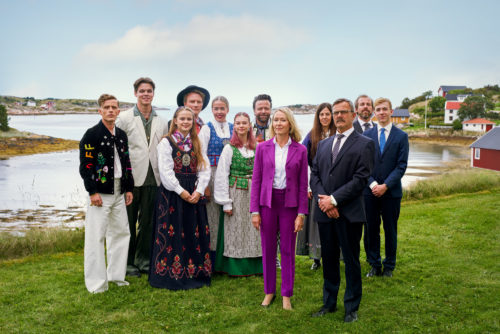1. Bunads: High Fashion, Norwegian Style
Forget the designer labels—on Billionaire Island, nothing says luxury quite like a bunad.
A bunad is a traditional Norwegian costume, with different styles representing various regions and communities across Norway. These garments are often worn on special occasions like weddings, confirmations, or Norway’s Constitution Day on May 17th. The design, embroidery, and accessories of a bunad are not just decorative but serve as markers of regional pride and, in some cases, family heritage. Each part of the outfit, from its intricate stitching to the silver jewelry that often accompanies it, reflects Norway’s rural and historical identity.

Though bunads have their roots in peasant clothing from the 18th and 19th centuries, they became popular as national symbols in the early 20th century as Norway sought to reclaim its cultural identity after gaining independence from Sweden. Today, while modern fashion dominates daily life, the bunad remains a powerful symbol of tradition and Norwegian pride.
Blonde ambition: Yes, you should watch Netflix’s new salmon drama
2. Nynorsk: Norway’s great spelling divide
When salmon tycoon Gjert Meyer demands that his wife’s birthday cake decoration be written in Nynorsk, it’s more than just a quirky character choice—it’s a loaded cultural statement with deep roots in Norway’s linguistic history. Here’s why:

Norway has two official written languages: Bokmål and Nynorsk. Bokmål is the more widely used form, heavily influenced by Danish, reflecting Norway’s historical ties with Denmark. Nynorsk, on the other hand, was created in the 19th century by linguist Ivar Aasen as a way to unify Norway’s various dialects and move away from Danish dominance after Norway gained independence in 1814.
Nynorsk became a symbol of Norwegian pride, especially for those in rural areas who felt that Bokmål didn’t represent their identity. Today, although only a small percentage of Norwegians use Nynorsk regularly, it remains a deeply significant choice for those who value tradition, regional culture, and independence.
3. Snus: The Tiny, Hidden Power Play
On Billionaire Island, the real flex is a pinch of snus. Its a character trait that helps bring Marlax CEO Julie Lange to life – a subtle act of defiance against the polished exterior she shows to the world.
But what is Snus? Snus is a moist, smokeless tobacco product that’s popular in Norway and Sweden. It’s placed under the upper lip and absorbed through the gums, offering a nicotine hit without the need for smoking. Snus has deep roots in Scandinavian culture, dating back to the 18th century, and has remained a common habit, particularly among men, though it’s gaining popularity across genders.

While smoking has decreased due to health concerns and regulations, snus has maintained its place in Norwegian culture, in part because it’s seen as a “less harmful” alternative to cigarettes. Despite ongoing debates about its health risks, snus has become a quiet yet constant part of daily life in Norway, and it’s often associated with a certain rugged, no-nonsense attitude.
Julie’s use of snus reflects this no-nonsense approach to power, her ability to blend tradition with modernity, and her willingness to break away from both gender and societal norms.


